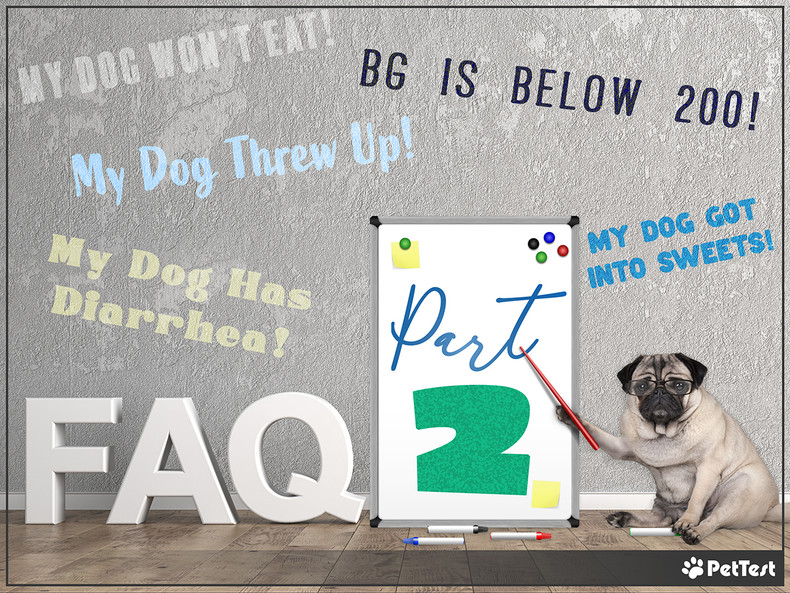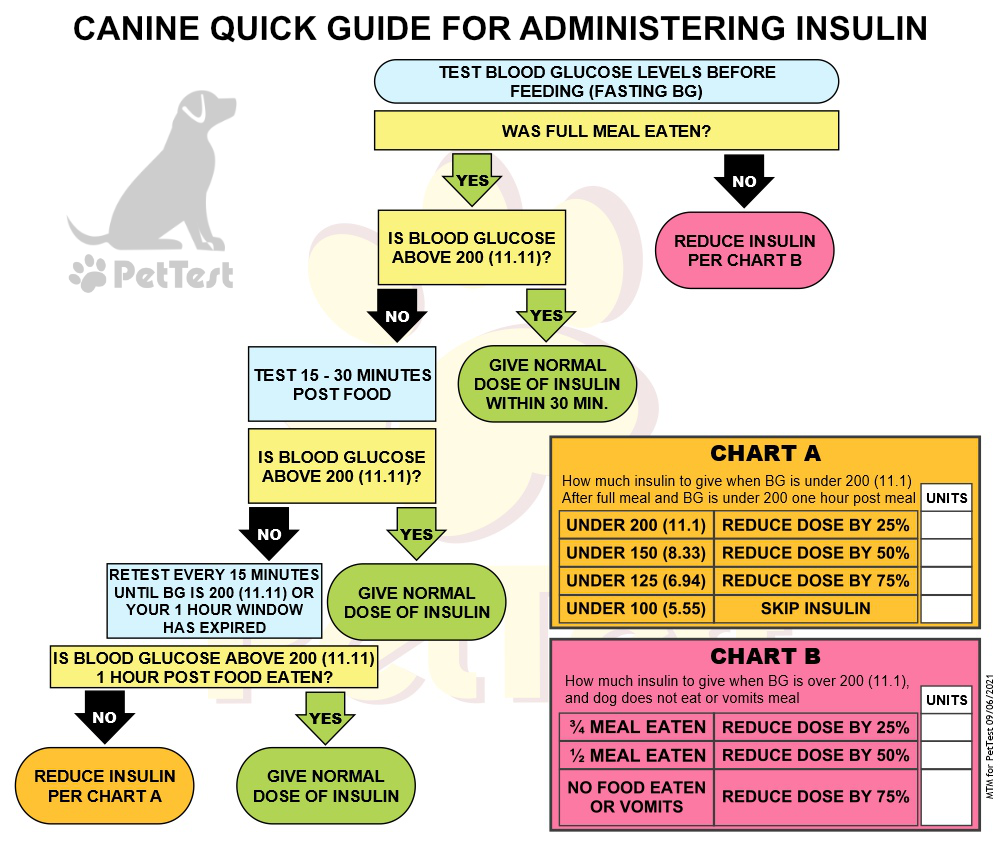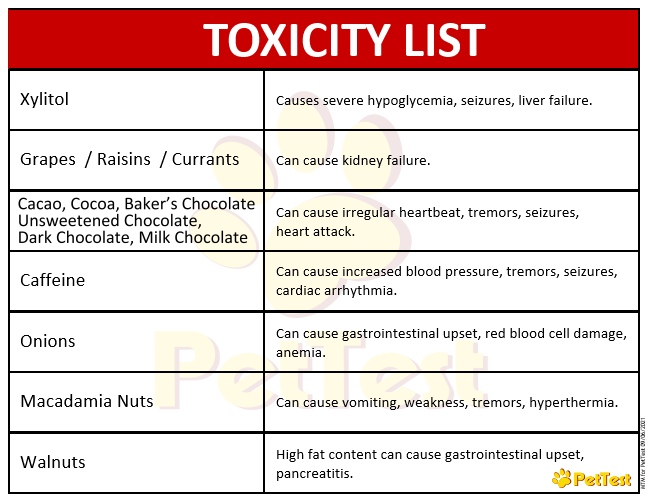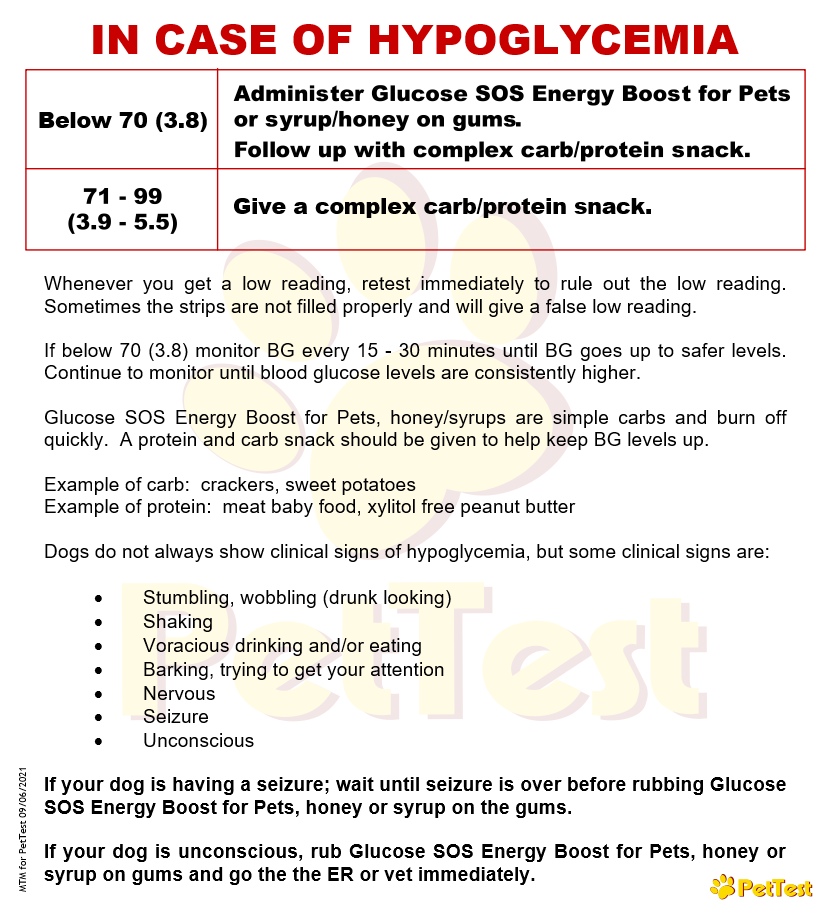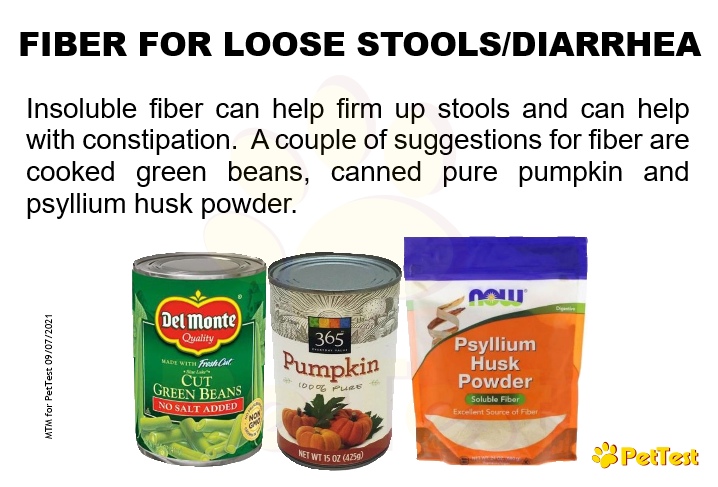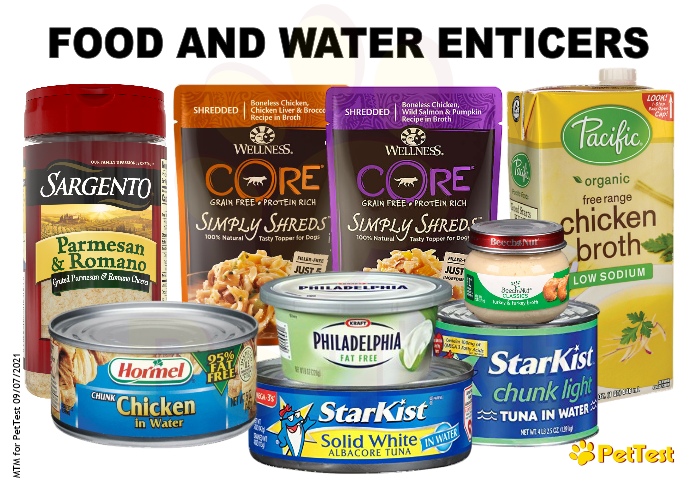FAQ: Part 2
Last week we talked about FAQ: Part 1 (frequently asked questions) that we are asked in our Facebook group Diabetic Dog Owners. I had the same questions after Lucy was first diagnosed with diabetes, usually after hours or on a weekend when my vet was closed! Today we are going to go over five more questions that are frequently asked. If you haven’t read FAQ: Part 1, click here to read.
Grab a cup of your favorite caffeinated beverage and let’s get to it!
My Dog’s Fasting Blood Glucose is Below 200 mg/dL (11.11 mmol/L)!
Testing blood glucose levels is extremely important and we recommend testing blood glucose levels at each fasting (before food and insulin) so that we know it is safe to give insulin. Occasionally our dogs can throw us a low reading at fasting.
If your dog’s fasting blood glucose level is below 200 mg/dL (11.11 mmol/L) retest to ensure that you got an accurate reading. If readings are correct then follow the chart below. If you continue to have low fasting blood glucose levels, running a curve is necessary to see what is going on throughout the day with insulin. To read about different types of curves, click here.
Pro tip: when retesting blood glucose levels to check for accuracy, remember that readings can have a 20% =/- variance. If your first reading is 185 (10.27) and your second reading is 148 (8.22) that is an acceptable variance.
(click on picture for printable JPG)
My Dog Got into Food / Sweets!
Our dogs are opportunists and will nab what they can when they can! When your dog gets into something that is nontoxic, encourage water consumption. Typically anything that is considered a simple carbohydrate; white bread, pizza crust, white rice, candy (see graphic below for chocolate) will burn off quickly. Complex carbohydrates like kibble, wheat bread, whole wheat pizza crust will take longer to burn off since they need to be digested and absorbed by the small intestine. High fat foods are a concern due to our dog’s pancreas being compromised, they are more prone to pancreatitis. Monitor for symptoms of GI upset/pancreatitis. Symptoms include hunched back (also called praying pose), vomiting, lethargy, painful abdomen, lack of appetite, diarrhea, shaking and cannot get comfortable. Please contact your vet as these are yellow or red-light symptoms and your dog should be seen by the vet as soon as possible. To read more about the functions of the pancreas and pancreatitis, click here.
If your dog has eaten something toxic, please contact your vet or ER vet immediately. Here is a toxicity list (please note this is not a complete list but the most common items dogs get into).
(click on picture for printable JPG)
And if your dog has gotten into a chocolate product you can use this calculator: Vets Now Chocolate Toxicity Calculator.
Take a deep breath, our dogs get into things!
My Dog Threw Up!
Sometimes our dogs eat too fast and vomit up their food and sometimes it’s due to GI issues. I know this sounds gross, but if they vomit and will re-eat it, let them. Since insulin and food is a fine dance we don’t know how much eaten food they vomited, and if possible we do not want to under feed or over feed. If insulin has not been given, follow the Quick Guide for Administering Insulin that is posted above. If they will not re-eat it or will not eat anything more, monitor blood glucose levels if insulin has already been given. Here is a chart for hypoglycemia.
(click on picture for printable JPG)
Make sure you monitor for symptoms of GI issues or pancreatitis. If your dog continues vomiting or has lack of appetite, please contact your vet or the ER vet.
Pro tip: If your dog is a food gulper, a slow feeder bowl helps slow them down. Don't have a slow feeder bowl? Try a muffin pan.
My Dog Has Loose Stools or Diarrhea!
This happens when a dog has eaten something that has upset their GI tract or they have pancreatitis, and sometimes when we transition to a new food they can have loose stools. To help firm up loose stools we can give insoluble fiber, it helps to bulk up waste. Canned pure pumpkin, cooked green beans and psyllium husk powder can all be safely given in small amounts to help with loose stools or diarrhea. If your dog has loose stools or diarrhea monitor for any other symptoms like lack of appetite, lethargy, vomiting, hunched back, shaking or cannot get comfortable. These are all signs of pancreatitis and a vet visit as soon as possible is necessary.
(click on picture for printable JPG)
FYI: Too much fiber can cause diarrhea, start with small amounts!
My Dog Won’t Eat!
Sometimes our dogs are just not hungry or they are picky. When this happens you can add low fat, carbohydrate free enticers to get them to eat. If your dog does not eat a meal or only eats a partial meal, please follow the Quick Guide for Administering Insulin that is posted above. If your dog is normally not picky and has lack of appetite for two consecutive meals you should contact your vet, lack of appetite is a yellow light warning and warrants a vet visit.
(click on picture for printable JPG)
Pro tip: save the juices from the canned chicken or tuna packed in water and freeze in ice cube trays for future use!
I hope this blog helps with these frequently asked questions, I know after Lucy was diagnosed and I ran into these issues having easy access to answers really helped me!
Until next week, stay cool and caffeinated!
If you have any questions, comments or suggestions, please start a conversation below.
If you are looking for a Facebook community to join for support, I have proudly been an admin in Diabetic Dog Owners for four and a half years. You can also join Canine Diabetes Support and Information on Facebook as well.
Be sure to join the PetTest family on Facebook and Instagram. PetTest has fun, interactive posts AND they have fabulous giveaways every week!
For a printable version of this blog click here.

